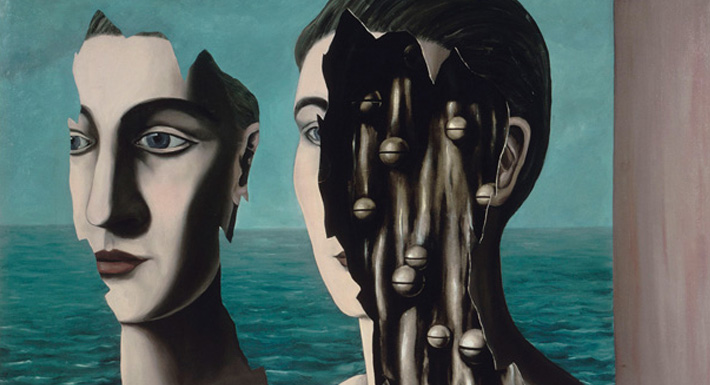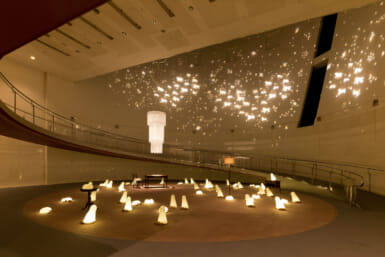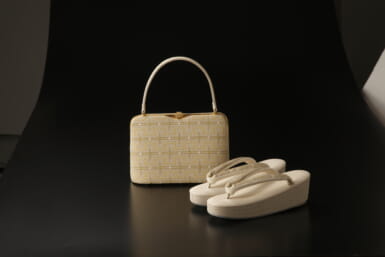The most pressing art of the last century can be divided into two camps: Get crazy or get freaky. Surrealism, the art/cultural movement on the freaky end of the scale, began in Europe in the early 1920s and spread across the world as a redress to the never-ending torrent of “get crazy” called Dada. A precursor to Surrealism that came out of Zurich, Dada broke all the rules, not only of art — visual arts especially — but culture as well.
Surrealism sought a refuge from Dada’s nihilism and the madness of World War I, but failed to find one; as it turned out, artistic conventions can’t actually counter a world gone crazy. As a result, they got freaky instead, which is just a few degrees left of crazy. By tapping into the unconscious human mind, the Surrealists discovered a limitless reservoir of imagery and power (its most common motif was the sexually liberated naked woman) with which to steer the flow of their creativity momentarily away from crazy, though ultimately it ended up straight back at the place they were trying to escape.
Still, a great deal can be said for reminding artists and art lovers to get freaky — one of many good reasons to visit “Surrealism: An Exhibition Organized With Artworks From The Centre Pompidou Collection”, showing till May 9 at The National Art Center Tokyo. Being freaky and gettin’ your freak on is everywhere to be seen here. You would have to be a nun, out of town, or out of your mind to miss this blockbuster.
Dada, inescapable as always, weighs heavily upon the exhibition: The curators, in some inexplicable fit of curatorial creativity — well, let’s just say it like it is, batshit craziness — have levitated a replica of a Marcel Duchamp readymade, “Porte-Bouteilles” (originally presented in 1914), 18 inches off the ground with fishing line, making this already nutty artwork freaking bizarre.
Lurking amid the tumultuous psyche of the times was the work of Dr. Freud and Dr. Jung Inc., who had recently revealed the depths of the unconscious, or the inner insanity of the individual versus the outer madness of the world around them. The unconscious proved to be such a vast source of material for an entire generation of whacked-out and shell-shocked artists that Andre Breton in the “Surrealism Manifesto” of 1924 singled out and championed dreams — among all the competing mental noise — as an inspiration for the creation of art (In this exhibition, again and again, it is the wet dream that dominates). The centerpiece of the exhibition is an original of the manifesto, which stands alone in a dark, spotlit room, as if it were a holy relic from the future past of Cirque du Soleil. Thankfully, it is not suspended by a fishing-line.
Viewing these artworks today, almost a 100 years later, is a trip. You can’t help but wish you could ask Giorgio de Chirico, Juan Miro, Salvador Dali, Alberto Giacometti, Matta and Yves Tanguy, “Just what were you guys thinking?”
As it happened, de Chirico, who predated the movement by a decade, only lasted 10 years in this freaky ether, from 1909-19. De Chirico’s “Mélancolie d’un après-midi “ (1913) is a deceptively complex painting, in which two artichokes dominate the foreground of a sparse man-made landscape. Look more closely, though, and a locomotive in the background breaks the silence with a burst of steam screaming through its whistle. You will find this tiny world-class painting bizarrely placed on a rather empty wall in the corner of an enormous room.
This conventional-yet-unconventional scene can be read at its simplest as a woman on her back at the moment of impregnation, but that does not do the work justice. At its most complex, the piece drags the history of painting into the Surreal new world of the 20th century: These two humongous edible buds, worthy of Pamela Anderson, barely squeeze into the tight, traditional picture plane, while high-up, way in the back, a long, black train — that makes me want to start writing ad copy for a Trojan condom box — suddenly comes sliding into view to blow its freaking wad sky high.
Many other surprises and revelations await visitors in the show, such as Victor Brauner’s descriptive drawings of posturing libidinous creatures, which would send film director Guillermo del Toro running to the gym. This exhibition holds real good adult art fun at its freakin’ very best. (LG WILLIAMS)
LG Williams can be reached at www.lgwilliams.com
Exhibition: “Surrealism: An Exhibition Organized With Artworks From The Centre Pompidou Collection”
(till May 9)
Venue: The National Art Center, Tokyo
(Roppongi and Nogizaka stations)
Hours: 10 am–6 pm (Friday till 8 pm; closed Tues.)
Admission: ¥1,500
More info: www.sur2011.jp
Or call (03) 5777-8600









